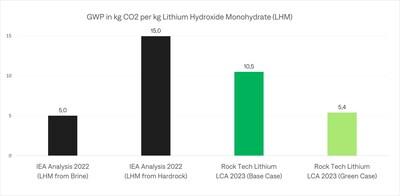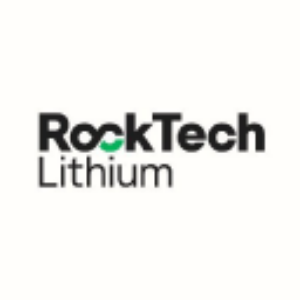Rock Tech';s Guben Converter Lithium Production Carbon Footprint is 30 Percent Lower than the International Energy Agency's Reported Average
- Fraunhofer UMSICHT conducted a Life Cycle Assessment (LCA) for battery-grade lithium hydroxide monohydrate (LHM) from the Guben Converter.
- The carbon footprint is calculated to be 10.5 kgCO2-eq./kg LHM.
- The footprint could be reduced to 5.4 kgCO2–eq./kg LHM through careful commercial selection of materials and energy suppliers.
- Rock Tech compared the results against an International Energy Agency (IEA) special report showing a carbon footprint 30 percent lower than the average for LHM from hard rock.
- Beyond the scope of the LCA, upcoming Zero-Waste solutions will bring further emission-saving potential.
Dirk Harbecke, Chief Executive Officer of Rock Tech, states, "We want to contribute to zero-emissions and battery electric vehicles, accepting the challenge to reduce the environmental impact of our lithium hydroxide. The LCA shows that we and our partners in the market have the power to bring about this change through commercial decisions."
The renowned German Fraunhofer UMSICHT has evaluated the "cradle-to-gate" environmental impact of battery-grade LHM to be produced at Rock Tech's Guben Converter, with an emphasis on the carbon footprint. The base case carbon footprint is projected to be 10.5 kg CO2-eq/kg LHM, encompassing all upstream emissions and an assumed distance of transit from
The main sources of emissions per 1 kilogram of LHM in the LCA scenarios were attributed to energy supply for the Guben Converter with 4.3 kg CO2-eq (average grid mix electricity, natural gas, and steam, excluding transport), mining and concentration of spodumene with 3.8 kg CO2-eq, and transportation and shipping of spodumene concentrate with 0.7 kg CO2-eq.
When compared against the International Energy Agency's (IEA) special study on "The Role of Critical Minerals in Clean Energy Transitions" (also see Table 1), Rock Tech's base carbon footprint is 30 percent lower. Furthermore, through mainly careful choice of suppliers, the Company has the ability to reduce emissions to 5.4 kg CO2-eq./kg LHM, which could be compared to the estimated carbon footprint of LHM from brine in the IEA special report.
In the base case scenario, credits of -1.0 kg CO2-eq./kg LHM are given to one by-product by applying the avoided burden approach.1 The assessment also shows different scenarios that could cut the emissions in half by commercial choice of suppliers alone, without adapting the conversion process.
Changing from an average grid mix to exclusively renewable sources might reduce the footprint by more than
The LCA did not take into account Rock Tech's ambitions2 towards a zero-waste scenario because the exact quantification of its influence could not yet be determined clearly. Nonetheless, the targeted use of by-products remains a strategic priority that could bring additional emission-saving potential beyond the scope of the present study. The same holds true when substituting natural gas with hydrogen. These measures will provide further considerable benefits in the future.
On behalf of the Board of Directors,
Dirk Harbecke
Chairman & CEO
_________________________________________ |
1 To effectively avoid greenwashing, credits from by-product utilization are not accounted for in the net sum emissions of Rock Tech LCA, although Rock Tech supports avoiding carbon emissions in an industry beyond the scope of the LCA. |
2 See also Rock Tech's press release "Implementing Zero-Waste: Rock Tech Lithium, GP Papenburg and Schwenk Zement Collaborate for Closer Commercial Utilisation of Lithium By-Products" issued 30 January, 2023. |
DATA AND CONFORMITY OF THE STUDY
The LCA takes into account several impact categories and examines the possible environmental impact of products, processes, and services throughout their lifecycle. This method ensures that all of the essential factors are assessed for a sustainable decision-making process. Secondary data is being used to calculate the carbon footprint of spodumene mining and concentration. All LHM manufacturing processes rely on primary data. The primary data originates from mass and energy flow sheets (activity data) from the Company's Bankable Project Study, which was published on November 4, 2022. Furthermore, the LCA has been critically assessed by an independent third party (DEKRA) in accordance with ISO 14071 (2016) paragraph 4.3.3 and ISO 14044 (2006) paragraph 6.2. The Company created a comparison of Rock Tech's carbon footprint to the IEA special report (see table 1), which is not subject to the LCA done by Fraunhofer or third-party verification by DEKRA.
ABOUT ROCK TECH
Rock Tech is a cleantech company with operations in
Neither the TSX Venture Exchange nor its Regulation Services Provider (as that term is defined in policies of the TSX Venture Exchange) accepts responsibility for the adequacy or accuracy of this release.
CAUTIONARY NOTE CONCERNING FORWARD-LOOKING INFORMATION
Certain statements contained in this news release constitute "forward-looking information" under applicable securities laws and are referred to herein as "forward-looking statements". All statements, other than statements of historical fact, which address events, results, outcomes or developments that the Company expects to occur are forward-looking statements. When used in this news release, words such as "expects", "anticipates", "plans", "predicts", "believes", "estimates", "intends", "targets", "projects", "forecasts", "may", "will", "should", "would", "could" or negative versions thereof and other similar expressions are intended to identify forward-looking statements. In particular, forward-looking statements contained in this news release include: statements and data from the LCA, including the carbon footprint calculations therein; the further potential reduction of the Company's carbon footprint and emissions; and the Company's future plans and expectations as described in the section "About Rock Tech".
Forward-looking statements by their nature are based on assumptions and involve known and unknown risks, uncertainties and other factors which may cause the actual results to differ materially from the forward-looking statements. The material factors or assumptions used to develop the forward-looking statements include: the type of mining and concentration of lithium; the distance required for transportation of concentrate; the mix of energy supply for the Guben Converter; the Company's ability to procure supplies and other equipment necessary for its business; that all required regulatory approvals and permits can be obtained on the necessary terms in a timely manner; and that financing will be available to the Company on commercial terms. There may also be other factors that cause actual results to differ materially from the forward-looking statements, including the risks, uncertainties and other factors discussed in the Company's most recent management's discussion and analysis and annual information form filed with the applicable securities regulators.
No assurances can be given that any of the events anticipated by the forward-looking statements will transpire or occur, and the Company cautions the reader not to place undue reliance upon any such forward-looking statements. The Company does not intend, nor does it assume any obligation to update or revise any of the forward-looking statements, whether as a result of new information, changes in assumptions, future events or otherwise, except to the extent required by applicable law.
Sources: | Original IEA values are reported in lithium carbonate equivalent (LCE) and were converted to LiOH.H20 using a 0.88 conversion rate. Adapted from International Energy Agency (IEA) Special Report: "The Role of Critical Minerals in Clean Energy Transitions" page 196 of revised version, March 2022: https://www.iea.org/reports/the-role-of-critical-minerals-in-clean-energy-transitions; accessed 22 May 2023. |
![]() View original content to download multimedia:https://www.prnewswire.com/news-releases/rock-techs-guben-converter-lithium-production-carbon-footprint-is-30-percent-lower-than-the-international-energy-agencys-reported-average-301832934.html
View original content to download multimedia:https://www.prnewswire.com/news-releases/rock-techs-guben-converter-lithium-production-carbon-footprint-is-30-percent-lower-than-the-international-energy-agencys-reported-average-301832934.html
SOURCE Rock Tech Lithium Inc.








